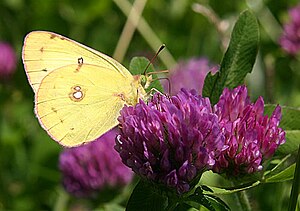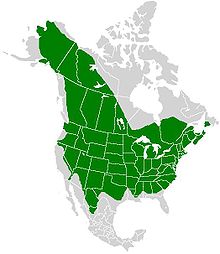Colias philodice
| Colias philodice | ||||||||||||
|---|---|---|---|---|---|---|---|---|---|---|---|---|

Colias philodice |
||||||||||||
| Systematics | ||||||||||||
|
||||||||||||
| Scientific name | ||||||||||||
| Colias philodice | ||||||||||||
| ( Godart , 1819) |
Colias philodice is a butterfly from the family of Whites (Pieridae). It is common in North America and isolated in Central America .
features
butterfly
The moths are between 50 and 70 millimeters in size and have a white to yellowish-white basic color, lighter colored animals are mostly females. Both sexes have black outer wing edges in the females the yellow to white basic color shines through. On the upper side of the fore and hind wings there is an eye spot . This is dark colored on the front wing and silver on the hind wing. It often appears in pairs and has a reddish frame. The undersides of the wings are uniformly yellow to yellowish-white, the eye-spots stand out clearly and are white on the hind wing with a black border. In the subspecies Colias philodice vitabunda , the females are mostly pure white. In spring and autumn the moths are smaller and less conspicuous.
egg
The eggs are cream-colored when they are laid, after a day or two they turn slightly reddish in color. They are ribbed elongated and tapered towards the ends. They are deposited individually on the leaves of the forage plant.
Caterpillar
The caterpillars have green-white or light yellow stripes on both sides and slightly raised, persistent black dots distributed over the body, as well as two light green narrow back lines. The species overwinters in the third caterpillar stage, occasionally also in the fourth.
Doll
The pupa is light green with yellowish-white marbling and red areas.
distribution and habitat
The species is widespread in North and Central America from southern Alaska to central and southeastern Canada, the bordering United States, with the exception of California, southern Texas and most of Florida . It is absent in northern Québec and Labrador . However, isolated populations have also been found in the highlands of Guatemala . Their territory, in which they spread out during their flights, is between 40 and 100 hectares in size. The moths are widespread and common and inhabit open fields, meadows, roadsides, and farmland.
Way of life and behavior
The moths can hybridize with Colia's eurytheme . In the north of its range, three generations per year are trained from May to October, in the south there are 4 to 5 generations from March to November. The subspecies Colias philodice vitabunda , which occurs in the north of the Canadian state of British Columbia and Alaska, only flies from June to mid-July. The lifespan of the moths varies between 2 and 17 days, with an average of 2 to 3 days. The longest recorded lifespan was found to be 2 weeks in a male and 24 days in a female. Their flight is fast and unpredictable, usually only about three feet above the ground. They use visual cues, e.g. B. the UV reflection of the wing scales and pheromones to communicate with each other.
nutrition
Food plants of the caterpillars are different Schmetterlingsblütler as clover ( Trifolium ), white clover ( Trifolium repens ), sweet clover ( Melilotus alba ), False indigo ( Baptisia tinctoria ), vetch ( Vicia ), and alfalfa ( Medicago sativa ) as well as plants from the family of pea ( Fabaceae ) and pea ( Pisum sativum ). Since there are many useful plants among these legumes , the caterpillars are regionally considered pests if they occur in large numbers.
Adult moths ingest nectar from various flowering plants, e.g. B. alfalfa ( Medicago sativa ), clover ( Trifolium ), but also silk plants ( Asclepias ), small brown ella ( Prunella vulgaris ) and wild teasel ( Dipsacus sylvestris ). The species is known to gather in clusters of multiple butterflies in damp spots and mud. It is believed that the butterflies consume salts and minerals here.
pairing
The mating behavior is quite well documented. Male moths fly towards the female and begin violently flapping their wings, touching the female's body. At the same time, pheromones are released from a gland on the top of the male's hind wings. As soon as the female detects these pheromones, she lowers her abdomen to mate. The pheromones can attract other females who approach the males while mating. Females younger than one hour cannot distinguish between the pheromones of their own species and Colias eurytheme . It is during this time that hybridizations occur most frequently . If a female mates with a male from Colias eurytheme , viable offspring are produced that can continue to reproduce in the next generation. If a female from Colias eurytheme and a male from Colias philodice mate , only sterile females are produced.
Subspecies
There are four sub-types: ITIS report.
- Colias philodice eriphyle ( WH Edwards , 1876) , southern British Columbia
- Colias philodice vitabunda ( Hovanitz , 1943) - southern Alaska and northern British Columbia
- Colias philodice guatemalena ( Staudinger ) - Guatemala , with broader brown margins on the top of the fore wings
- Colias philodice philodice ( Godart , 1819) - the nominate form , in the rest of the distribution area
Individual evidence
- ↑ a b c d e f g h i Butterflies and Moth of North America , English, accessed on September 18, 2014
- ↑ a b c d e f g h i j k l m n o Colias philodice in the Animal Diversity Web, English, accessed on September 18, 2014
- ^ A b c Entomology Collection , accessed October 3, 2014
- ^ A b Canadian Biodiversity Information Facility , accessed October 3, 2014
- ↑ a b c James A. Scott: The Butterflies of North America: A Natural History and Field Guide. Stanford University Press, Stanford 1992, pp. 198-199 ISBN 978-0804720137
- ^ ITIS Report , accessed September 6, 2014
- ^ Bernard D'Abrera: Butterflies of the Neotropical Region. Part 1 Papilionidae & Pieridae. Lansdowne Edition, Melbourne, 1981, ISBN 0-7018-1033-5 , p. 104
literature
- Elizabeth Balmer: Butterflies: Recognizing and Identifying. Parragon Books Ltd., Cologne 2007 ISBN 978-1407512037 , p. 55
- James A. Scott: The Butterflies of North America: A Natural History and Field Guide. Stanford University Press, Stanford 1992, pages 198-199 ISBN 978-0804720137



